| Srl | Item |
| 1 |
ID:
152900
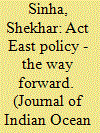

|
|
|
| 2 |
ID:
163771
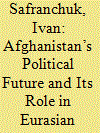

|
|
|
|
|
| Summary/Abstract |
While it is widely admitted that Afghanistan can contribute to connectivity in Eurasia, one may not also deny that Afghanistan’s regional role is dependent on regional conditions. This article takes Afghanistan’s security and geostrategic trends in Eurasia as the two major variables, defining conditions for Afghanistan’s regional role. They are reviewed and then synthesised as dependent and independent variables to form taxonomy of possible regional roles for Afghanistan.
|
|
|
|
|
|
|
|
|
|
|
|
|
|
|
|
| 3 |
ID:
082309
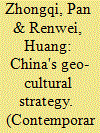

|
|
|
| 4 |
ID:
051381


|
|
|
| 5 |
ID:
139195
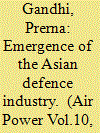

|
|
|
|
|
| Summary/Abstract |
East Asia is a region of contradictions. While it contributes an equal share to world Gross Domestic Product (GDP) as North America, it is also home to four flashpoints: the Taiwan Straits, Korean Peninsula, East China Sea and South China Sea. Countries in the region are bound to each other by economic linkages through trade and production networks, which have led the region to have a joint stake in its shared prosperity. However, increasing economic interdependence, while being a deterrent for conflict, falls short of becoming a cause for peace. Inability to resolve the historical legacies and boundary disputes, the competition for resources, the rise of China, the US pivot to Asia, the unstable regime of North Korea and the changing Japanese security identity are some of the multifarious security problems for the region. This constant clash of strategic aspirations to dominate the region ensures that military instruments will play a critical role in Asia.
|
|
|
|
|
|
|
|
|
|
|
|
|
|
|
|
| 6 |
ID:
053389
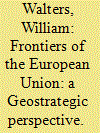

|
|
|
|
|
| Publication |
Autumn 2004.
|
| Summary/Abstract |
While state borders remain the pre-eminent frontiers within geopolitics, regional blocs are also acquiring frontier characteristics. How might we understand the function and identity of such frontiers? Taking the European Union as its focus, this article offers answers to these questions by developing the idea of geostrategy. Four geostrategies are identified: networked (non)borders, march, colonial frontiers and limes. Each corresponds with a particular way of territorialising the space of the border, as well as a certain idea of ‘inside’ and ‘outside’, and of the risks and problems that the border is to govern. A geostrategic perspective uses contemporary social forms (such as networks) but also historical forms of borders (march, limes) in order to enhance the intelligibility of the frontiers of the EU. As such, this approach seeks to capture the multiplicity and plurality of borders.
|
|
|
|
|
|
|
|
|
|
|
|
|
|
|
|
| 7 |
ID:
119128
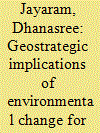

|
|
|
| 8 |
ID:
020191
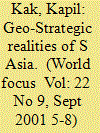

|
|
|
|
|
| Publication |
Sept 2001.
|
| Description |
5-8
|
|
|
|
|
|
|
|
|
|
|
|
|
|
|
|
| 9 |
ID:
018344
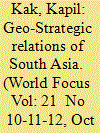

|
|
|
|
|
| Publication |
Oct-Nov-Dec 2000.
|
| Description |
8-11
|
|
|
|
|
|
|
|
|
|
|
|
|
|
|
|
| 10 |
ID:
063794


|
|
|
| 11 |
ID:
139793
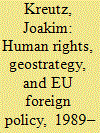

|
|
|
|
|
| Summary/Abstract |
Is foreign policy influenced by humanitarian concerns, or are concepts such as human security merely rhetoric for traditional power politics? Using a multilevel modeling technique and a unique data set of military and economic European Union (EU) intervention 1989–2008, I find that military and economic interventions by the EU are conducted in response to humanitarian atrocities but that geostrategic concerns also influence EU action. While the EU consistently is more likely to act against countries with greater civilian victimization, the size of the effect is influenced by spatial considerations. The EU is most attentive to human rights violations in non-EU European states, followed by countries in sub-Saharan Africa, while it has been least active in Asia and the Americas.
|
|
|
|
|
|
|
|
|
|
|
|
|
|
|
|
| 12 |
ID:
051417


|
|
|
|
|
| Publication |
2004.
|
| Description |
p77-99
|
| Summary/Abstract |
Although the threat of mass casualty terrorism has altered strategic priorities in the United States, the global community as a whole faces many of the same problems that it faced in the 1990s: civil wars; failed or failing states; and other humanitarian disasters around the world. The gap between the demands on the international community to do something about these catastrophes and its ability to respond remains wide. The challenge to create a truly global capacity for peacekeeping and humanitarian intervention is difficult, but not so daunting or expensive as to excuse inaction. With minimal investments, which would primarily entail states shifting military resources and force structures towards more useful ends, superior global capabilities to make a difference are achievable.
|
|
|
|
|
|
|
|
|
|
|
|
|
|
|
|
| 13 |
ID:
057112


|
|
|
| 14 |
ID:
130236
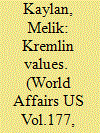

|
|
|
|
|
| Publication |
2014.
|
| Summary/Abstract |
After Forbes magazine named Vladimir Putin the most powerful man in the world, a status he has surely consolidated by overseeing the Winter Olympics and the invasion of Crimea, one heard a great deal of media talk about the Russian leader's wily skills in playing the global geostrategic "game." What one didn't hear, what one virtually never hears, even from highly experienced Western commentators on Russian affairs, is anything about Putin acting according to principles or pursuing actions according to a coherent ideology. Not surprising, you might say, since the man obviously has no such concerns-other than a will to win, for himself and his seat of power; no vision comparable to that of the Kremlin in the old Soviet Union, which furnished it and its allies with a huge asset and a troublesome headache in the form of an armory of fully rationalized ideas that legitimized a predictable approach to international relations and even provided the regime with a perverse "morality."
|
|
|
|
|
|
|
|
|
|
|
|
|
|
|
|
| 15 |
ID:
076052


|
|
|
| 16 |
ID:
090464


|
|
|
| 17 |
ID:
175948
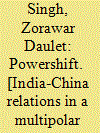

|
|
|
|
|
| Publication |
New Delhi, Macmillan, 2020.
|
| Description |
xi, 335p.Hbk
|
| Standard Number |
9789389109726
|
|
|
|
|
|
|
|
|
|
|
|
Copies: C:1/I:0,R:0,Q:0
Circulation
| Accession# | Call# | Current Location | Status | Policy | Location |
| 059938 | 327.54051/SIN 059938 | Main | On Shelf | General | |
|
|
|
|
| 18 |
ID:
123439


|
|
|
|
|
| Publication |
2013.
|
| Summary/Abstract |
This article calls for an expansion in the study of Asian geopolitics beyond the Indo-Pacific axis. China's geostrategic rise and that of Asia's other main powers are phenomena that bear multiple maritime and continental manifestations. Insofar as Asia's powers meet in different regions, the "primary" Indo-Pacific theater cannot be isolated from developments in Central, South, Southeast, Northeast Asia, the northwestern Pacific, or the Arctic. By conceptualizing seapower and landpower as an interactive dyad in geostrategy and zooming in on the maritime and continental directions of China, India, and Russia, this article depicts Asia as an increasingly interdependent geopolitical whole.
|
|
|
|
|
|
|
|
|
|
|
|
|
|
|
|
| 19 |
ID:
165143


|
|
|
|
|
| Summary/Abstract |
Since 2011, Myanmar has undertaken a series of domestic and foreign policy reforms, including democratisation and peacebuilding, before and after the watershed November 2015 elections in the country. These reform processes have called into question whether China, which has been Myanmar's dominant great power neighbour throughout the previous era of military government in the country formerly known as Burma, would find its strategic position eroding as Myanmar further opens to the international community. However, the concept of China ‘losing’ diplomatic ground to other actors, including the West, in Myanmar implies a zero-sum game that does not adequately address Beijing's still-formidable geostrategic presence vis-à-vis its southern neighbour. China has now started to implement a more multi-faceted, ‘resilience network’-building approach to maintaining its special status in Myanmar's foreign policy, a situation which will persist as Myanmar continues its uncertain path towards further reform.
|
|
|
|
|
|
|
|
|
|
|
|
|
|
|
|
| 20 |
ID:
109791
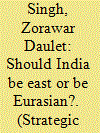

|
|
|